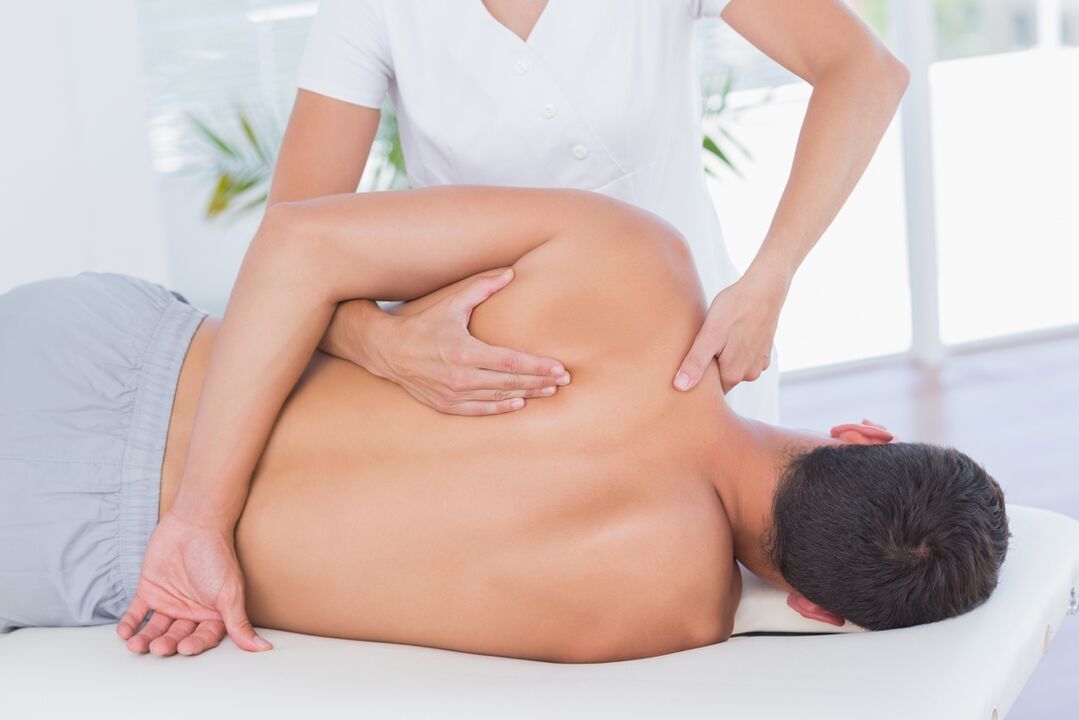Pain under the left shoulder in the back of the back is a symptom that occurs in both the elderly and the young. Muscle tension after physical exertion or chronic flexion can cause discomfort. The concentration of pain from the back to the back indicates not only diseases of the musculoskeletal system: problems with the chest organs and abdominal cavity are possible. If the discomfort under the shoulder on the left side increases, it is necessary to consult a specialist.

Anatomical features
The stalk is closely connected to the clavicle, forming the clavicle-shoulder joint. On some sides, the coastal arches and the vertebral axis are attached to the shoulder blades. The listed bone formations maintain the shape of the chest and back.
The lungs and heart are at the level of the thoracic segment of the spine. Problems with these organs can cause pain. Also, discomfort occurs due to the tightening of the nerve roots of the spinal cord, located in the spinal canal (near the shoulder blade).
Causes of discomfort in the shoulder area
There are 5 main groups of causes of pain that appear:
- Diseases of the musculoskeletal system: variants of intercostal neuralgia, arthritis of the shoulder joints, neoplasms. Degenerative-dystrophic changes in the vertebral axis - osteochondrosis, hernias, extensions, myositis - can also become a provocative factor.
- Cardiovascular diseases: angina pectoris, myocardial infarction, infections of the cardiac layers (myocarditis, pericarditis, endocarditis).
- Pathologies of the bronchopulmonary system: bronchitis, inflammation of the lungs or pleura, tuberculosis.
- Gastrointestinal problems: chronic pancreatitis, peptic ulcer, spleen damage.
- Shoulder injury of various origins: trauma, inflammation, tuberculosis.
How to get rid of pain on the left side of the back under the shoulder
If the diagnosis has already been confirmed by a doctor (osteochondrosis or chronic pancreatitis), it is necessary to adhere to the recommendations given earlier.
Musculoskeletal disorders in the acute phase require the use of pain relievers and anti-inflammatory drugs. Care should be taken when using warming oils: apply the medicine strictly to the shoulder region, without affecting the projection of the heart. Otherwise, it can cause a rapid heart attack and rhythm disruption.
In chronic pancreatitis or peptic ulcer disease, a special diet is required, taking enzymes or antiulcer medications according to the scheme.
Any discomfort forces you to reduce physical activity: the patient is shown rest. For sleep, it is recommended to choose an orthopedic pillow and mattress.
Important! If the pain under the left shoulder blade persists with a change in body position and does not subside at rest, you should urgently consult a physician to rule out acute myocardial infarction.
Possible diseases
List of diseases accompanied by pain symptoms:
- bursitis- inflammation of the periarticular sac of the shoulders. Due to injuries or excessive loads, soft tissues swell, pressure occurs in nearby muscles, ligaments, tendons. Unpleasant sensations during raising the hand gradually turn into an acute pain syndrome, which also appears in the dream. Bacterial (septic) bursitis is a consequence of mucosal infection. Characterized by a rise in temperature, redness of the skin of the shoulder, severe pain.
- Osteochondrosis of the thoracic region.Degenerative changes in the structure of intervertebral discs provoke muscle spasms, tightening of nerve roots, vascular bundles. The clinical picture begins with a tingling sensation in the chest or back. Increased discomfort is accompanied by loss of sensation in the fingers and shoulder girdle.
- Intervertebral hernia.Destruction of the cartilaginous capsule of the intervertebral nucleus has more pronounced clinical manifestations. There is paresis and paralysis of the upper limbs. Discs with growing hernias are often complicated by mild to moderate neuropathic pain. The peculiarity of such pains is the lack of effect in the background of taking non-steroidal anti-inflammatory drugs.
- Mioziti.Inflammatory process of skeletal muscle arising from infections or trauma. The most severe form of the disease is ossification of the subscapularis muscle (ossification of muscle tissue).
- Angina pectoris- a pathological condition accompanied by a lack of blood supply to the heart muscle. Angina pectoris is characterized by back pain under the left shoulder blade, acute spasmodic pain behind the sternum. Severe stress, smoking, alcohol abuse provoke an attack.
Diagnosing
Western medicine turns to the aid of hardware diagnostics in order to rule out problems of the musculoskeletal system. To make a final diagnosis, the patient must undergo:
- Radiography of the cervical spine and thorax.
- Ultrasound for bursitis shows excess fluid in the capsule of the synovial joints.
- Computed tomography.
- Magnetic resonance imaging.
If a patient is suspected of miosis, a thorough blood test is required to confirm the inflammatory process.
If cardiac pathology is suspected, allopaths perform the following examination methods:
- Electrocardiogram.
- A blood test that determines the factors of myocyte necrosis.
- Ultrasound of the heart.
Treatment and prevention of the disease
Therapies and doses vary depending on the form of the disease and its severity.
- Pathology of the musculoskeletal system requires the appointment of non-steroidal anti-inflammatory drugs (for pain relief), muscle relaxants, vitamin complexes. In difficult clinical cases, Western doctors recommend the elimination of pain syndrome with hormonal agents. Minimally invasive shoulder surgery is often used to treat bursitis.
- Myositis is treated with warming gels and oils, anti-inflammatory drugs. Physiotherapy is recommended during remission. With severe pain, allopaths make novocaine blockages.
- Angina attacks are stopped by nitrate-like compounds. According to medical protocols, patients need injections of blood-thinning medications to prevent blood clots. With high blood pressure, patients take antihypertensive pills. To normalize the rhythm, doctors prescribe antiarrhythmics. They also recommend taking cholesterol-lowering medication, metabolic therapy.































